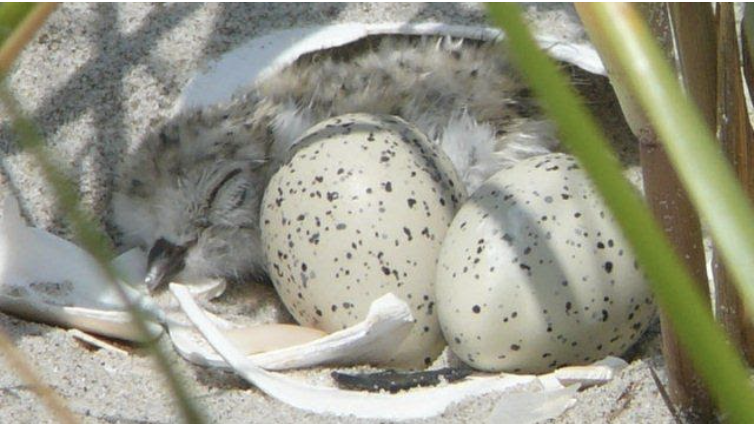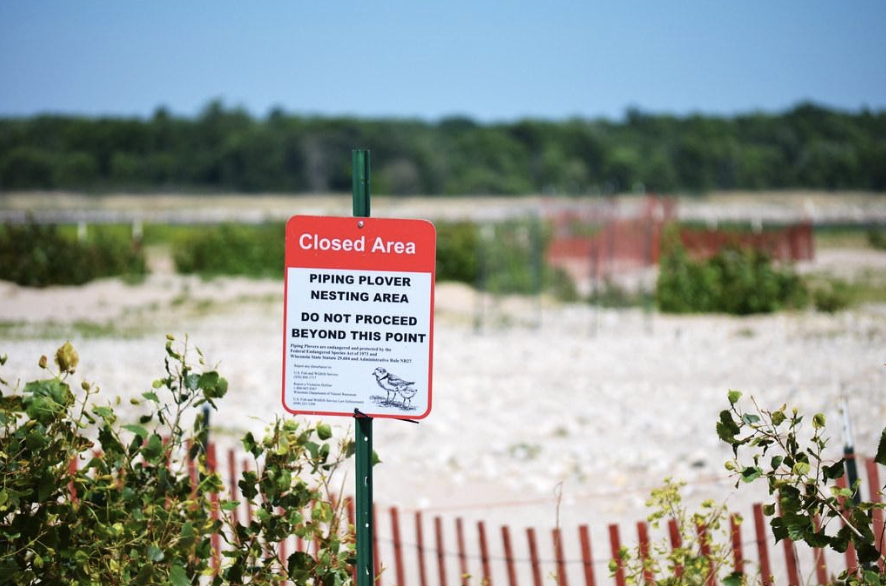The Plight of the Piping Plover: How Climate Change affects shorebirds?
Author: Audrey Kaiser, Edited by: Dr. Priya Roy
Shore birds are important members of marine ecosystems. They help regulate coastal populations of fish, crustaceans, and insects by feeding on them. Just like many other birds, they are increasingly vulnerable to human development, drastic weather events, and other consequences of global climate change.
Want to know more about the different types of Shore Birds then click here:
(1) https://myodfw.com/wildlife-viewing/species/shore-birds
(2) https://www.thespruce.com/types-of-shorebirds-387309
(3) https://www.allaboutbirds.org/guide/browse/shape/Shorebirds
Figure 1: The Piping Plover Bird (Source: https://commons.wikimedia.org/wiki/File:Piping_plover.jpg)
Have you ever gone to the beach and seen a tiny bird darting back and forth? There is a good chance that it was the Piping plover (Figure 1). In this article we will focus on this single bird and its struggle dealing with climate change.
What do they look like?
Piping plovers are small shore birds that exclusively breed in North America (1).
They are mainly identified by their tan plumage, a bright orange, black tipped beak, and black bars across their breast and forehead that disappear in the winter (1).
Have a black stripe across their chest that is much broader in males compared to females.
These birds feed on a variety of organisms, including worms, insects, and crustaceans (2).
In the last few decades, Piping plover populations have declined severely, mostly due to several aspects of human induced changes in their environments which have resulted in them being placed on the “Near Threatened” category in the IUCN List (1).
Find out more about these birds here
Figure 2: The Piping Plovers on the beach (Source: https://pixnio.com/fauna-animals/birds/plover-birds-pictures/piping-plover/piping-plovers-eating-on-the-beach)
Where are they Found?
There are currently three populations of Piping plover that exist in the United States: the Great Lakes population, the Atlantic Coast population, and the Great Plains population. These are there primary nesting and breeding habitats. The map below shows the distribution of known populations. After the breeding season, all three of these populations migrate South to spend the winter along the Gulf Coast, South Atlantic, and Caribbean beaches (1). They are considered federally endangered in the Great Lakes region and are threatened in the Atlantic Coast and Great Plains. In their winter range all three populations are considered threatened according to the IUCN Red List (1). In Canada, they are listed as Endangered (2).
Figure 3: Known Piping plover populations in U.S and Canada: Northern Great Plains (yellow), Great Lakes (red), Atlantic Coast (green), and wintering range for all populations (blue). Source: U.S Fish and Wildlife Service
How do they live?
Piping plovers build their nests in open, vulnerable areas along the shoreline (Figure 3). Generally, these areas include sandbars, coastal beaches, sand dunes with little vegetation, gravel, and habitats of similar composition (1).
They arrive at their breeding habitat around mid-March through mid-May and depart after 3-4 months (1).
Each female bird only lays 3-4 eggs per breeding season (1).
These nests are very well camouflaged, and extremely sensitive to any kind of disturbance.
Figure 3: A newly hatched Piping plover chick asleep with its unhatched siblings in an open, sandy nesting site. Source: National Parks Service
How and Why are they Endangered?
Much of the ideal breeding habitat for Piping plovers has disappeared, causing sharp declines in population. A large part of their decline has been due to coastal development and human recreation on beaches (3).
The construction of roads and buildings has majorly interrupted their habitat and breeding success, and the increased foot and vehicular traffic threatens their exposed nests.
Their camouflaged nests are often crushed, or abandoned by the mother if in an area of high disturbance (5).
Other direct consequences of this are human trash that attracts more predators, and unmonitored pets on beaches that interfere with nesting sites (5).
In addition to modern day disturbance, Piping plovers were once sought after for their plumage in the hat-making industry. They used to be abundant along coasts, but were hunted excessively in the late 19th century (5).
Their population began to recover from this after the Migratory Bird Act was passed in 1918, but again began to decline in mid-century in tandem with the increase of human development (5).
What else is hurting them – Sea level rise
In addition to human development, sea level rise and storm surges due to increased temperature brought by climate change are threats to these populations. In the next 100 years, sea levels are expected to increase by 0.18 m to 2m according to several studies. Consequences of rising sea levels could prove detrimental for fragile marine populations, resulting in flooding from extreme weather events and increased erosion (3). One study predicts a 1.5 m sea level rise may trigger a loss of 6 million hectares of eastern United States seacoast land, where one of the larger populations of plovers exist (4). Increased storm activity, flooding and erosion will greatly challenge their ability to breed and survive.
A 2011 study predicts that sea level rise is likely to reduce breeding areas (without migration) of a Piping plover population on barrier islands in Suffolk, NY. They also predict that if they do migrate, habitat has a chance of increasing, but paired with human development, migration habitat may decrease by 5%-12%. Lastly, they predict that a large hurricane could flood up to 95% of Piping plover habitat on the barrier islands in NY (3).
Figure 4: Beach closure sign to protect endangered Piping plover nesting habitat. Source: U.S Fish and Wildlife Service Midwest on Flickr
To know more about their current status and future trends, click here
What is being done to protect them?
Piping plovers are currently facing several forms of adversity. To prevent the loss of these shorebirds, conservation efforts must be increased. This means limiting shoreline development, restricting access to breeding habitat, and protecting nesting sites during breeding season (Figure 4). Closed areas like the one above are a great way to raise awareness of the species and prevent any disturbance from the public. Another great resource to increase knowledge and conservation efforts is citizen science. This interactive map from Audubon Field Guide uses data to predict change in Piping plover habitat based on climate change under different warming scenarios (6). Hopefully, the tiny shorebird will migrate and attempt to broaden its distribution as their ideal habitat shrinks. In the meantime, we can work together to protect them.
To know more about specific conservation efforts, click here.
Citations:
(1) U.S Fish and Wildlife: https://www.fws.gov/plover/facts.html
(2) American Bird Conservancy: https://abcbirds.org/bird/piping-plover/?gclid=CjwKCAjwguzzBRBiEiwAgU0FTxGNv4H6CfbpDpumEVy-XR9ArZnOhmnF_te-NTgof1iqzS9Djl0bvxoCW4kQAvD_BwE
(3) Seavey, J. R., Gilmer, B., & McGarigal, K. M. (2011). Effect of sea-level rise on piping plover (Charadrius melodus) breeding habitat. Biological conservation, 144(1), 393-401.
(4) Titus, J. G., & Richman, C. (2001). Maps of lands vulnerable to sea level rise: modeled elevations along the US Atlantic and Gulf coasts. Climate research, 18(3), 205-228.
(5) https://www.endangered.org/animal/piping-plover/
(6) Audubon Field Guide interactive map: https://www.audubon.org/field-guide/bird/piping-plover





